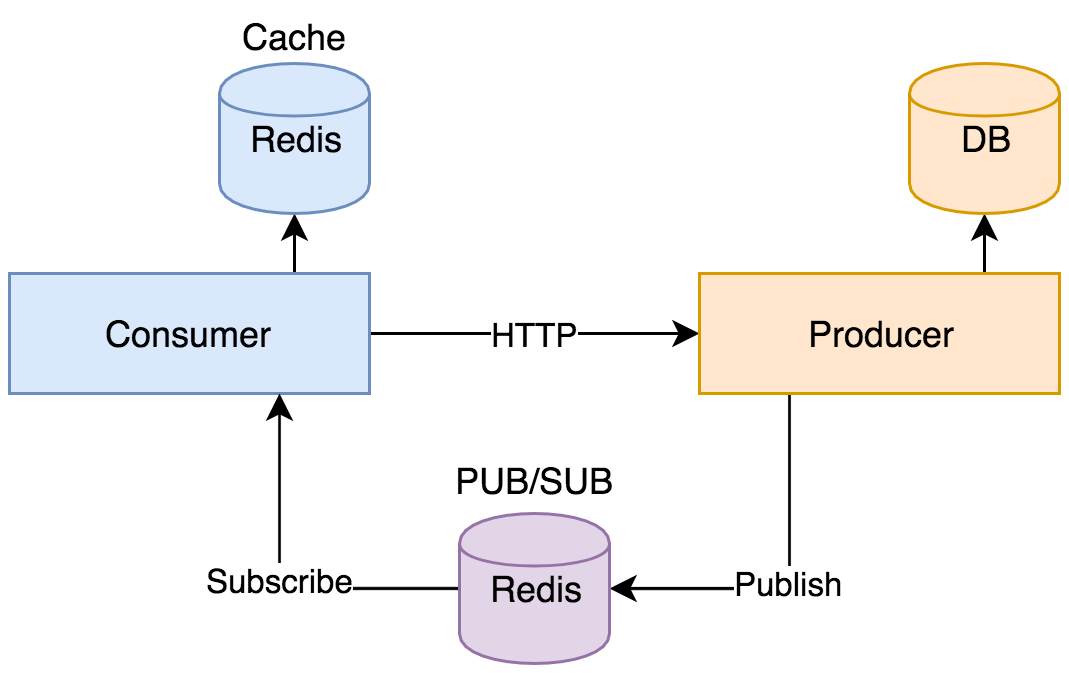Caching with Redis
Presented by @tlhunter@mastodon.social

Distributed Systems with Node.js: bit.ly/34SHToF
I: The Basics
What is caching?
- Caches make your application faster
- Cache problems must not break app
- Getting outdated data from cache could be bad
There are only two hard things in Computer Science: cache invalidation and naming things.— Phil Karlton
Pseudocode: Read
- This forms the basis of all caching
MY_RECORD = CACHE.GET("RECORD_100")
IF NOT MY_RECORD
MY_RECORD = DATABASE.GET("RECORD_100")
CACHE.SET("RECORD_100", MY_RECORD)
RETURN MY_RECORDPseudocode: Modify
- Easy if app writing to DB also writes to Cache
DATABASE.SET("RECORD_100", NEW_RECORD)
// These two are almost the same
CACHE.SET("RECORD_100", NEW_RECORD)
CACHE.DELETE("RECORD_100")Nomenclature
- Naming considerations to prevent collision
- Must contain the minimum to identify data
- Take keyname byte length into consideration
appversion-collection-cversion-etc:id v5-animaltypes-v2-en_US:123
II: Passive Cache Invalidation
Expiration / TTL
- Set a Time To Live (TTL) on a per-key basis
- Each command has a millisecond equivalent
SETEX keyname 120 "my text" SET keyname "my text" EX 120 SET keyname "my text" EXPIRE keyname 120 EXPIREAT keyname epoch TTL keyname TOUCH keyname
Key Eviction
- Delete (evict) keys when low on memory
- Set the maximum memory Redis is allowed to use
- These changes are global for the Redis instance
- You may want multiple Redis instances per app
maxmemory 512mb maxmemory-policy <policy-name>
Key Eviction Policies
noeviction: Error when adding data (default)allkeys-lru*: Evict any key based on last usageallkeys-random*: Evict any key randomlyvolatile-lru: Evict TTL key based on last usagevolatile-random: Evict TTL key randomlyvolatile-ttl: Evict a key with shortest TTL
* Entire Redis instance is now volatile
LFU: Least Frequently Used (Redis 4.0)
- Evict keys which aren't used that frequently
allkeys-lfu*: Evict any infrequently used keyvolatile-lfu: Evict TTL infrequently used key
* Entire Redis instance is now volatile
Pattern: Expire on Read
- Store object as hash with time metadata
- Track expiry time but don't use key TTL
- Quickly reply to a request with old data
- Immediately update cache with new data
- E.g. first read of the day has last nights data
Pattern: Expire on Read
META = CACHE.GET("R100")
REPLY(META.DATA) // Potentially old Data
IF META.EXPIRE < NOW
NEW = DATABASE.GET("R100")
LATER = NOW.ADD("2 DAYS")
CACHE.SET("R100", DATA: NEW, EXPIRE: LATER)III: Active Cache Invalidation
Distributed Systems Complexity
- The simple cache set/delete no longer works
- How does Consumer know when to update cache?

Distributed Systems Naive Approach
- Consumers connect to a Producer-owned cache
- Doubles the size of the API surface
- Doubles the documentation, locations for error, etc.
- Why not just have Producer be really fast?

Pub/Sub to the Rescue
- Here is a method we can use to invalidate caches
- Producer publishes a message describing resource
- Consumer is in charge of updating/removing data

Pub/Sub to the Rescue
- Subscribe to channels representing collections
- Many producers could use the same Redis server
- Publish enough information to identify the resource
SUBSCRIBE service-name:collection:version
PUBLISH service-name:collection:version
'{"lang":"en_US","id":123}'
PUBLISH service-name:collection:version
'{"lang":"en_US","id":123,"name":"xyz"}'
Questions?
- Follow me: @tlhunter@mastodon.social
- Distributed Systems with Node.js: bit.ly/34SHToF